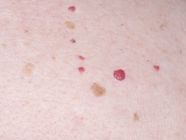It’s natural to feel concerned when you notice small red bumps suddenly covering your child’s body, especially if they are accompanied by itching.
Sudden allergic reactions are often triggered by exposure to everyday substances, such as food allergens, airborne allergens like pollen, or contact with skin products. While these substances are harmless to most children, those with allergies have a sensitive immune system that overreacts, treating these triggers as threats. This leads to rashes and other allergic symptoms. (1)
However, it’s important to note that not every rash or itch is caused by an allergy—some cases may be due to infections or other skin conditions.
What Are the Causes of Sudden Skin Allergies in My Child?
Allergic symptoms may appear when your child’s skin comes in contact with a triggering substance, or when they inhale or ingest it, as with food allergies. Here are the most common causes of sudden skin allergies:
1- Food Allergies
Food allergy is one of the most common types of allergies among children. The most frequent triggers include milk, eggs, wheat, peanuts, tree nuts, soy, fish, shellfish, and sesame.
Symptoms usually appear within minutes to two hours of eating the food, but in rare cases, may be delayed for several hours. (2)
2- Pollen
This allergy occurs after inhaling pollen—tiny particles released by trees and grasses that travel through the air—causing symptoms like sneezing, nasal congestion, watery eyes, and skin rash.
Pollen allergies may persist year-round or occur only in specific seasons, depending on the type of pollen your child is allergic to. (3)
3- Medication Allergies
Children may develop allergies to certain medications, with symptoms appearing seconds or hours after taking the drug.
Common triggers include certain antibiotics, aspirin, or topical treatments. (3)
4- Skincare Products and Cleaning Agents
Some children may develop skin allergies from using skincare or cleaning products like soap, shampoo, creams, or sunscreen. This is usually due to the presence of fragrances or specific chemicals, particularly in children with sensitive skin. (4)
5- Fabrics and Clothing
Irritation may be caused by wool, certain synthetic fibers, or clothing that contains dyes. (4)
6- Pet Dander
If you’ve recently brought home a cat or dog, or your child visited a place with a pet, they might develop symptoms within minutes or hours.
Removing the animal from the environment is the best solution, though pet dander can remain in the house for weeks or even months. (3)
7- Insect Bites
The most common insect bites that may cause allergic reactions in children include stings from wasps, bees, or fire ants. The reaction may be limited to the bite area or—more rarely—become severe and require urgent medical attention. (3)
8- Mold and Humidity
Mold is a type of microscopic fungus that thrives in humid environments. Its spores can be inhaled and may trigger symptoms including skin rashes. Mold is particularly dangerous for children with asthma. (3)
9- Eczema
Eczema differs from the previous causes as it is not technically an “allergy,” but still causes skin irritation and itching.
It is a chronic skin condition that makes the skin dry, inflamed, and itchy. Symptoms occur in repeated flare-ups triggered by cold weather, sweating, harsh soaps and detergents, sunlight, heat, and other irritants.
Eczema often runs in families with a history of allergic conditions. Treatment involves regular moisturizing, avoiding known triggers, and sometimes topical corticosteroids prescribed by a doctor. (4)
10- Heat and Sweating (Heat Rash)
High heat and excessive sweating can cause heat rash—small red bumps that appear especially in skin folds or covered areas. Though not an allergy in the strict sense, it causes similar rash-like symptoms. (5)
How Can I Determine the Cause of My Child’s Skin Allergy?
The first step is to gather information about what might have triggered the allergic reaction. For example, if your child recently took an antibiotic and developed a skin reaction afterward, the medication might be the cause. Try to review all possible factors from the causes listed above.
Once you have an idea, consult a doctor. They may perform an allergy test, a simple procedure where small amounts of potential allergens are applied or pricked onto the skin. If a specific substance causes swelling or rash, your child may be allergic to it. (3)
If you’d like to schedule an allergy test for your child, you can book an appointment with the Dermatology Department at Al-Ahli Hospital, where we offer accurate diagnoses and personalized treatment.
References
- Asthma and Allergy Foundation of America - Skin Allergies
- WebMD - 10 Common Allergy Triggers
- Allergy and Asthma Network - All About Allergies
- ACAAI - Skin Allergy
- Raising Children Network - Heat rash






